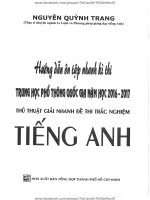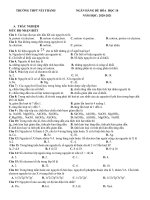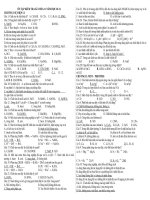- Trang chủ >>
- Văn Mẫu >>
- Văn Miêu Tả
Tiếng Anh - Hướng dẫn ôn tập thi giữa HK 1 năm học 2020-2021
Bạn đang xem bản rút gọn của tài liệu. Xem và tải ngay bản đầy đủ của tài liệu tại đây (137.26 KB, 4 trang )
<span class='text_page_counter'>(1)</span><div class='page_container' data-page=1>
PHỊNG GIÁO DỤC VÀ ĐÀO
TẠO QUẬN BÌNH TÂN
****
<b>Trường THCS Tân Tạo </b>
<b>HƯỚNG DẪN CHẤM KIỂM TRA GIỮA KÌ</b>
<b>Năm học 2020-2021</b>
<b>Mơn : TIẾNG ANH - LỚP 9</b>
<i><b>Thời gian làm bài: 45phút (Không kể thời gian giao đề)</b></i>
<i><b>(</b><b>Đề thi này gồm 4 trang)</b></i>
Họ và tên thí sinh__________________________
Trường:__________________________________
Lớp:_____________________________________
Chữ ký giám thị 1 Chữ ký giám thị 2 SỐ CỦA MỖI BÀI
Từ 1 đến 30 do Giámthịghi
SỐ PHÁCH
do CT HĐ chấmthighi
<b>Điểm bằng số</b> <b>Điểm bằng chữ</b> Chữ ký giám khảo
1 Chữ ký giám khảo 2
SỐ PHÁCH
do CT HĐ chấmthighi
SỐ CỦA MỖI BÀI
Từ 1 đến 30 do Giámthịghi
<b>TEST 1B (ANSWER KEY)</b>
<i><b>I. Choose the word / phrase (A, B, C or D) that best fits the space in each sentence. (2.5 pts)</b></i>
1. Liz met Ba’s family _____ his house early _____ the morning.
A. to / in <b>B. at / in</b> C. for / in D. in / for
2. The workers love wearing jeans because the material was very ________.
<b>A. strong</b> B. fashionable C. during D. cheap
3. “Would you mind if I use your dictionary?” “Of course not, _________.”
A. Don’t do that. <b>B. It’s over there.</b>
C. I’m sorry I can’t. D. I have a dictionary.
4. He used to _______ full time, but now he is a part time worker.
<b>A. work </b> B. working C. worked D. works
5. We often enjoy the _______ air in the countryside.
A. pollute B. forest C. food <b>D. fresh</b>
6. We have lived in Hanoi ______ four years.
A. in B. since <b>C. for </b> D. at
7. It seems difficult for us ________ abroad at the moment.
A. go <b>B. to go </b> C. went D. gone
8. Beautiful scenery is usually a rich source of _______ for an artist.
A. pattern B. tradition C. design <b>D. inspiration </b>
9. “My mother is ill in hospital.” “_______”
A. I don’t think so. C. No problem.
<b>C. I’m sorry to hear that.</b> D. Oh, she is unlucky.
10. Tourists should wear _______ clothes when they visit hot countries in the summer.
A. traditional B. tight <b>C. loose</b> D. formal
Chú ý: Thí sinh chỉ ghi mẫu tự A, B, C, hoặc D vào ô trả lời.
<i><b>Answers: </b></i><b>1. ________2. ________3. ________4. ________ 5. ________</b>
<b> 6. ________7. ________8. ________9. ________10. ________</b>
</div>
<span class='text_page_counter'>(2)</span><div class='page_container' data-page=2>
<i><b>THÍ SINH KHƠNG ĐƯỢC VIẾT GÌ VÀO PHÁCH NÀY</b></i>
<i><b>=========================================================================</b></i>
<i><b>II. </b></i>
<i><b> </b><b>Look at the signs. Choose the best answer (A, B, C or D) for questions11 and 12</b><b> (0.5 pt)</b></i>
11. What does the sign (A) say? A. crossroad ahead
B. roundabout ahead
C. narrow road ahead
<b>D. no U-turn</b>
12. What does the sign (B) say?
A. No passing allowed.
B. No playing on the street.
C. No pedestrian traffic.
<b>D. No parking allowed.</b>
Chú ý: Thí sinh chỉ ghi mẫu tự A, B, C, hoặc D vào ô trả lời.
<i><b>Answers:</b></i><b> 11. ___________ 12. ___________ </b>
<i><b>III. Read the following passage. Decide if the statements from 13 to 16 are True or False and choose</b></i>
<i><b>the correct answers (A, B, C, or D) for questions 17 and 18. (1.5 pt)</b></i>
The word jeans comes from a kind of material that was made in Europe. The material, called jean,
was named after sailors from Genoa in Italy because they wore clothes made from it. In the 18th<sub> century</sub>
jean cloth was made completely from cotton and workers at that time loved wearing it because the
material was very strong and it did not wear out easily. In the 1960s, many university and college
students wore jean. Designers made different styles of jeans to match the 1960s’ fashions: embroidered
jeans, painted jeans and so on.
13. Jeans come from a kind of material that was made in The USA.
14. Jean cloth was made completely from cotton in 1760s.
15. Workers liked wearing jeans because they were very strong and hardly wore out.
16. The embroidered jeans and painted jeans were fashionable in the 1970s.
Thí sinh viết đầy đủ từ True hoặc False vào ô trả lời.
<i><b>Answers:</b></i><b> 13. ___False____ 14. ___True___ 15. ___True___ 16. ___False____</b>
17. Who were the first people to wear jeans?
<b>A. Sailors</b> B. Americans
C. Designers. D. University and college students.
18. In the 1960s , _____ students wore jeans.
A. some B. all of <b>C. a lot of</b> D. only
Chú ý: Thí sinh chỉ ghi mẫu tự A, B, C, hoặc D vào ơ trảlời.
<i><b>Answers:</b></i><b>17. ________18._________</b>
<i><b>THÍ SINH KHƠNG ĐƯỢC VIẾT GÌ VÀO PHÁCH NÀY</b></i>
</div>
<span class='text_page_counter'>(3)</span><div class='page_container' data-page=3>
<i><b>=========================================================================</b></i>
<i><b>IV. Choose the word (A, B, C or D) that best fits the blank space in the following passage. (1.5 pt)</b></i>
The capital of Malaysia is Kuala Lumpur and it is also the largest city in the country. The (19)
__________ in 2001 was over 22 million. Islam is the country’s official religion. In (20)________, there
are other religions such as Buddhism and Hinduism. The national (21) ____ is Bahasa Malaysia (also
known simply as Malay). English, Chinese, and Tamil are also(22) ____ spoken. The language of
instruction for primary school children is Bahasa Malaysia, Chinese, or Tamil. Bahasa Malaysia is the
(23)________ language of instruction in all secondary schools, (24)____ some students may continue
learning in Chinese or Tamil. And English is a compulsory second language.
19
.
A. country B. capital C. city <b>D. population </b>
20
.
A. short B. conclusion <b>C. addition</b> D. area
21
.
A. subject B. religion C. population <b>D. language </b>
22
.
A. openly <b>B. widely</b> C. closely D. compulsory
23
.
<b>A. primary</b> B. second C. mother tongue D. compulsory
24
.
A. however B. but <b>C. although </b> D. despite
Chú ý: Thí sinh chỉ ghi mẫu tự A, B, C, hoặc D vào ô trả lời.
<i><b>Answers: </b></i><b>19. ________20._________21._________ 22._________23.________24. _________</b>
<i><b>V. Use correct form of the word given in each sentence. (1.5 pt)</b></i>
25. It is said that he’s lived in a ______peaceful______ village near Oxford. <b>(peace)</b>
26. His parents’ words were a great ______encouragement_____ to him. <b>(encourage)</b>
27. The school yard needs to be _____carefully_______ cleaned up. <b>(care)</b>
28. There is a big old banyan tree at the _____entrance______ to the village. <b>(enter) </b>
29. Red _____symbolizes_______ the victory. <b>(symbol) </b>
30. I like to wear this shirt because. It’s _____comfortable_____. <b>(comfort)</b>
<i><b>Answers: </b></i><b> 25. __________________ 26._______________________ 27. _______________________ </b>
<b> 28.___________________29._______________________30. _______________________</b>
<i><b>VI. Rearrange the groups of words in a correct order to make complete sentences. (0.5 pt) </b></i>
31. all over the world. / with young people / very popular / Jeans are
32. of the local people / on us. / made a deep impression / The friendliness/
<i><b>Answers:</b></i>
31. Jeans are very popular with young people all over the world.
32. The friendliness of the local people made a deep impression on us.
</div>
<span class='text_page_counter'>(4)</span><div class='page_container' data-page=4>
<i><b>THÍ SINH KHƠNG ĐƯỢC VIẾT GÌ VÀO PHÁCH NÀY</b></i>
<i><b>=========================================================================</b></i>
<i><b>VII. Rewrite each of the following sentences in another way so that it means almost the same as the</b></i>
<i><b>sentence printed before it. (2.0 pts) </b></i>
33. Learning Japanese is difficult.
It ________________________________________________________
34. I haven’t seen her for a long time.
I didn’t___________________________________________________________
35. Tom wrote that letter yesterday.
That letter<i><b>____________________________________________________________________</b></i>
36. I’m sorry that I don’t finish my homework.
I wish___________________________________________________________________________
<i><b>Answers:</b></i>
33. It is difficult to learn Japanese.
34. I didn’t see her a long time ago.
35. That letter was written by Tom yesterday.
36. I wish I finished my homework.
<b>THE END OF THE TEST</b>
</div>
<!--links-->







